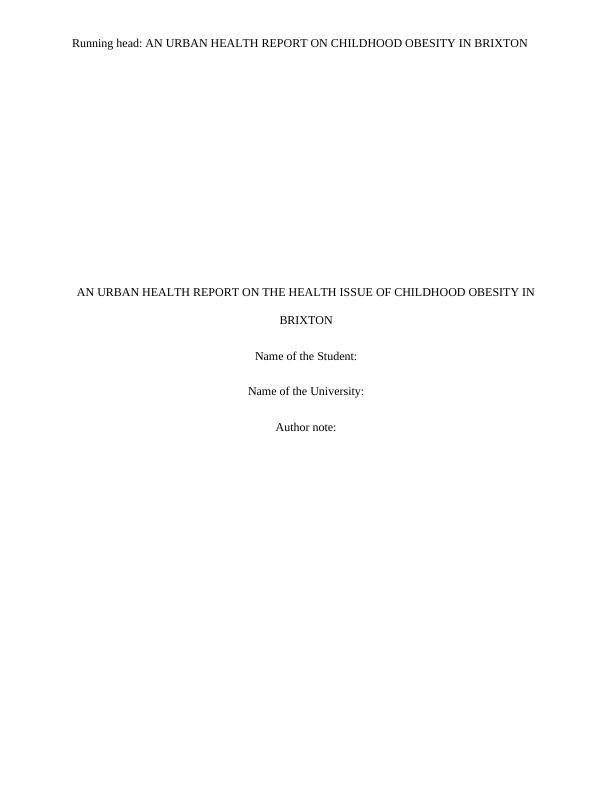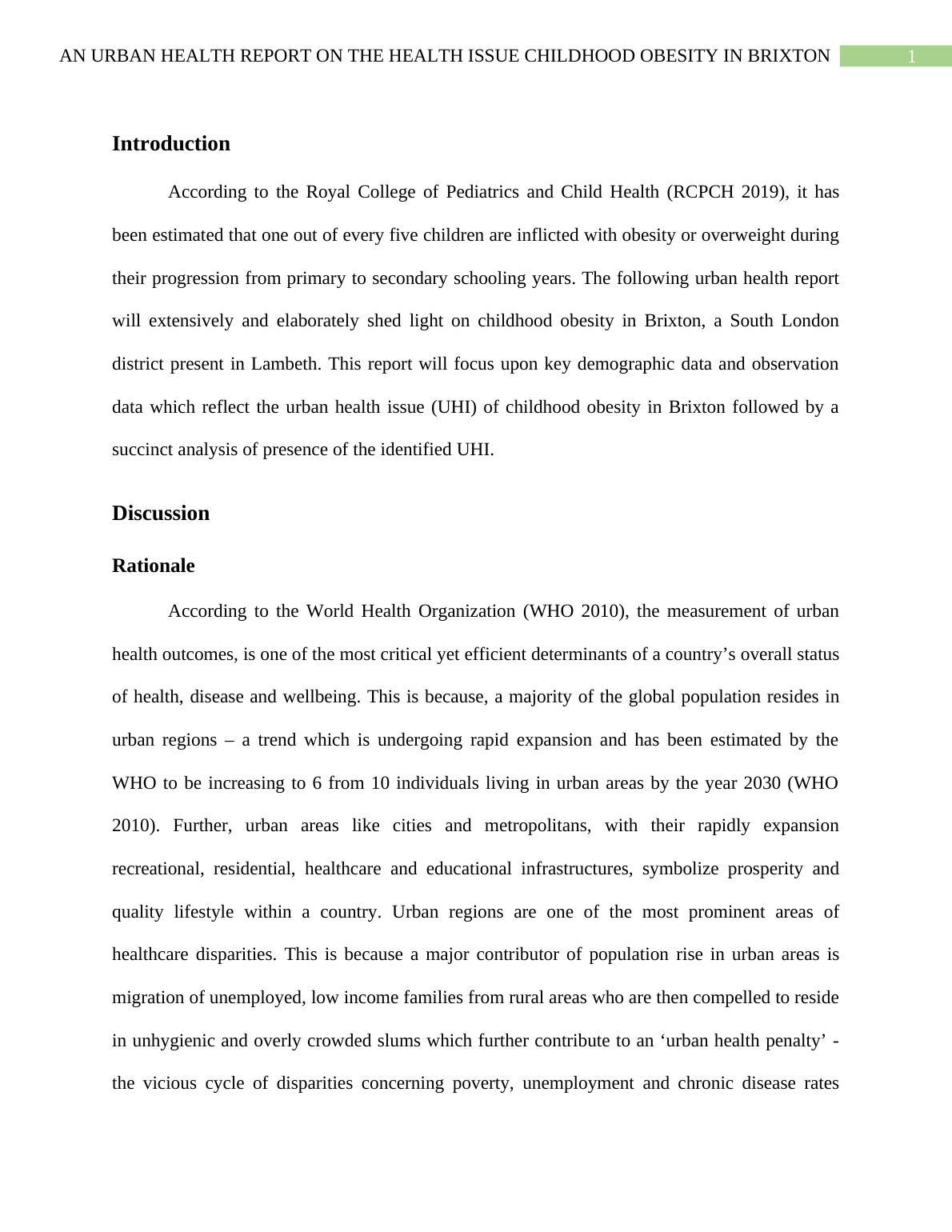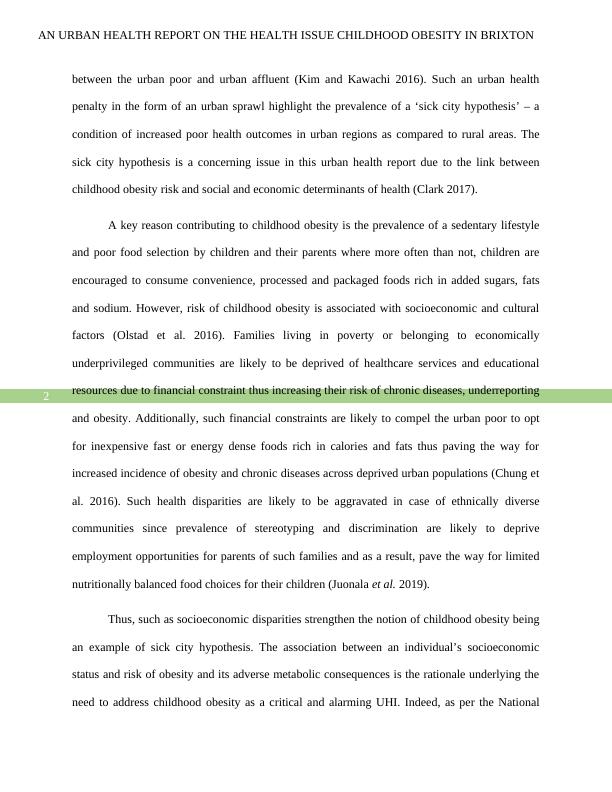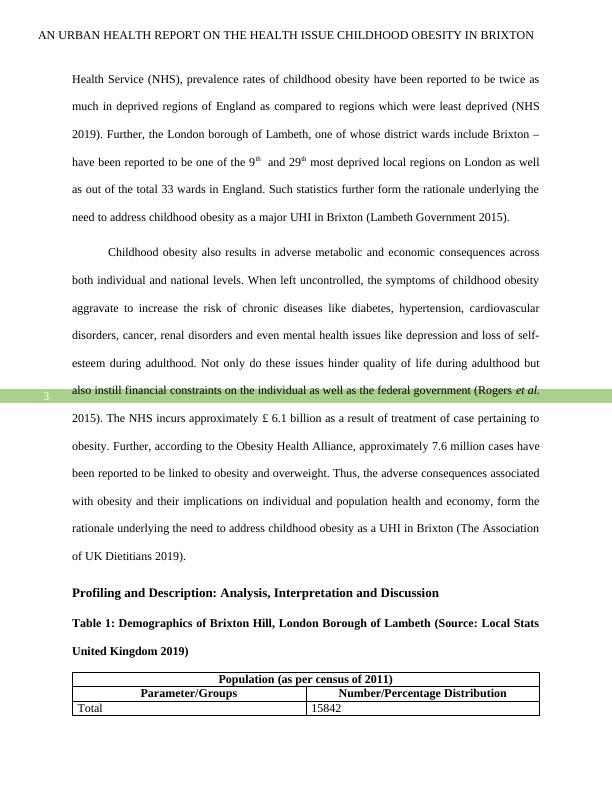AN URBAN HEALTH REPORT ON THE HEALTH ISSUE CHILDHOOD OBESITY
18 Pages4474 Words19 Views
Added on 2022-09-03
AN URBAN HEALTH REPORT ON THE HEALTH ISSUE CHILDHOOD OBESITY
Added on 2022-09-03
ShareRelated Documents
Running head: AN URBAN HEALTH REPORT ON CHILDHOOD OBESITY IN BRIXTON
AN URBAN HEALTH REPORT ON THE HEALTH ISSUE OF CHILDHOOD OBESITY IN
BRIXTON
Name of the Student:
Name of the University:
Author note:
AN URBAN HEALTH REPORT ON THE HEALTH ISSUE OF CHILDHOOD OBESITY IN
BRIXTON
Name of the Student:
Name of the University:
Author note:

AN URBAN HEALTH REPORT ON THE HEALTH ISSUE CHILDHOOD OBESITY IN BRIXTON
1
Introduction
According to the Royal College of Pediatrics and Child Health (RCPCH 2019), it has
been estimated that one out of every five children are inflicted with obesity or overweight during
their progression from primary to secondary schooling years. The following urban health report
will extensively and elaborately shed light on childhood obesity in Brixton, a South London
district present in Lambeth. This report will focus upon key demographic data and observation
data which reflect the urban health issue (UHI) of childhood obesity in Brixton followed by a
succinct analysis of presence of the identified UHI.
Discussion
Rationale
According to the World Health Organization (WHO 2010), the measurement of urban
health outcomes, is one of the most critical yet efficient determinants of a country’s overall status
of health, disease and wellbeing. This is because, a majority of the global population resides in
urban regions – a trend which is undergoing rapid expansion and has been estimated by the
WHO to be increasing to 6 from 10 individuals living in urban areas by the year 2030 (WHO
2010). Further, urban areas like cities and metropolitans, with their rapidly expansion
recreational, residential, healthcare and educational infrastructures, symbolize prosperity and
quality lifestyle within a country. Urban regions are one of the most prominent areas of
healthcare disparities. This is because a major contributor of population rise in urban areas is
migration of unemployed, low income families from rural areas who are then compelled to reside
in unhygienic and overly crowded slums which further contribute to an ‘urban health penalty’ -
the vicious cycle of disparities concerning poverty, unemployment and chronic disease rates
1
Introduction
According to the Royal College of Pediatrics and Child Health (RCPCH 2019), it has
been estimated that one out of every five children are inflicted with obesity or overweight during
their progression from primary to secondary schooling years. The following urban health report
will extensively and elaborately shed light on childhood obesity in Brixton, a South London
district present in Lambeth. This report will focus upon key demographic data and observation
data which reflect the urban health issue (UHI) of childhood obesity in Brixton followed by a
succinct analysis of presence of the identified UHI.
Discussion
Rationale
According to the World Health Organization (WHO 2010), the measurement of urban
health outcomes, is one of the most critical yet efficient determinants of a country’s overall status
of health, disease and wellbeing. This is because, a majority of the global population resides in
urban regions – a trend which is undergoing rapid expansion and has been estimated by the
WHO to be increasing to 6 from 10 individuals living in urban areas by the year 2030 (WHO
2010). Further, urban areas like cities and metropolitans, with their rapidly expansion
recreational, residential, healthcare and educational infrastructures, symbolize prosperity and
quality lifestyle within a country. Urban regions are one of the most prominent areas of
healthcare disparities. This is because a major contributor of population rise in urban areas is
migration of unemployed, low income families from rural areas who are then compelled to reside
in unhygienic and overly crowded slums which further contribute to an ‘urban health penalty’ -
the vicious cycle of disparities concerning poverty, unemployment and chronic disease rates

AN URBAN HEALTH REPORT ON THE HEALTH ISSUE CHILDHOOD OBESITY IN BRIXTON
2
between the urban poor and urban affluent (Kim and Kawachi 2016). Such an urban health
penalty in the form of an urban sprawl highlight the prevalence of a ‘sick city hypothesis’ – a
condition of increased poor health outcomes in urban regions as compared to rural areas. The
sick city hypothesis is a concerning issue in this urban health report due to the link between
childhood obesity risk and social and economic determinants of health (Clark 2017).
A key reason contributing to childhood obesity is the prevalence of a sedentary lifestyle
and poor food selection by children and their parents where more often than not, children are
encouraged to consume convenience, processed and packaged foods rich in added sugars, fats
and sodium. However, risk of childhood obesity is associated with socioeconomic and cultural
factors (Olstad et al. 2016). Families living in poverty or belonging to economically
underprivileged communities are likely to be deprived of healthcare services and educational
resources due to financial constraint thus increasing their risk of chronic diseases, underreporting
and obesity. Additionally, such financial constraints are likely to compel the urban poor to opt
for inexpensive fast or energy dense foods rich in calories and fats thus paving the way for
increased incidence of obesity and chronic diseases across deprived urban populations (Chung et
al. 2016). Such health disparities are likely to be aggravated in case of ethnically diverse
communities since prevalence of stereotyping and discrimination are likely to deprive
employment opportunities for parents of such families and as a result, pave the way for limited
nutritionally balanced food choices for their children (Juonala et al. 2019).
Thus, such as socioeconomic disparities strengthen the notion of childhood obesity being
an example of sick city hypothesis. The association between an individual’s socioeconomic
status and risk of obesity and its adverse metabolic consequences is the rationale underlying the
need to address childhood obesity as a critical and alarming UHI. Indeed, as per the National
2
between the urban poor and urban affluent (Kim and Kawachi 2016). Such an urban health
penalty in the form of an urban sprawl highlight the prevalence of a ‘sick city hypothesis’ – a
condition of increased poor health outcomes in urban regions as compared to rural areas. The
sick city hypothesis is a concerning issue in this urban health report due to the link between
childhood obesity risk and social and economic determinants of health (Clark 2017).
A key reason contributing to childhood obesity is the prevalence of a sedentary lifestyle
and poor food selection by children and their parents where more often than not, children are
encouraged to consume convenience, processed and packaged foods rich in added sugars, fats
and sodium. However, risk of childhood obesity is associated with socioeconomic and cultural
factors (Olstad et al. 2016). Families living in poverty or belonging to economically
underprivileged communities are likely to be deprived of healthcare services and educational
resources due to financial constraint thus increasing their risk of chronic diseases, underreporting
and obesity. Additionally, such financial constraints are likely to compel the urban poor to opt
for inexpensive fast or energy dense foods rich in calories and fats thus paving the way for
increased incidence of obesity and chronic diseases across deprived urban populations (Chung et
al. 2016). Such health disparities are likely to be aggravated in case of ethnically diverse
communities since prevalence of stereotyping and discrimination are likely to deprive
employment opportunities for parents of such families and as a result, pave the way for limited
nutritionally balanced food choices for their children (Juonala et al. 2019).
Thus, such as socioeconomic disparities strengthen the notion of childhood obesity being
an example of sick city hypothesis. The association between an individual’s socioeconomic
status and risk of obesity and its adverse metabolic consequences is the rationale underlying the
need to address childhood obesity as a critical and alarming UHI. Indeed, as per the National

AN URBAN HEALTH REPORT ON THE HEALTH ISSUE CHILDHOOD OBESITY IN BRIXTON
3
Health Service (NHS), prevalence rates of childhood obesity have been reported to be twice as
much in deprived regions of England as compared to regions which were least deprived (NHS
2019). Further, the London borough of Lambeth, one of whose district wards include Brixton –
have been reported to be one of the 9th and 29th most deprived local regions on London as well
as out of the total 33 wards in England. Such statistics further form the rationale underlying the
need to address childhood obesity as a major UHI in Brixton (Lambeth Government 2015).
Childhood obesity also results in adverse metabolic and economic consequences across
both individual and national levels. When left uncontrolled, the symptoms of childhood obesity
aggravate to increase the risk of chronic diseases like diabetes, hypertension, cardiovascular
disorders, cancer, renal disorders and even mental health issues like depression and loss of self-
esteem during adulthood. Not only do these issues hinder quality of life during adulthood but
also instill financial constraints on the individual as well as the federal government (Rogers et al.
2015). The NHS incurs approximately £ 6.1 billion as a result of treatment of case pertaining to
obesity. Further, according to the Obesity Health Alliance, approximately 7.6 million cases have
been reported to be linked to obesity and overweight. Thus, the adverse consequences associated
with obesity and their implications on individual and population health and economy, form the
rationale underlying the need to address childhood obesity as a UHI in Brixton (The Association
of UK Dietitians 2019).
Profiling and Description: Analysis, Interpretation and Discussion
Table 1: Demographics of Brixton Hill, London Borough of Lambeth (Source: Local Stats
United Kingdom 2019)
Population (as per census of 2011)
Parameter/Groups Number/Percentage Distribution
Total 15842
3
Health Service (NHS), prevalence rates of childhood obesity have been reported to be twice as
much in deprived regions of England as compared to regions which were least deprived (NHS
2019). Further, the London borough of Lambeth, one of whose district wards include Brixton –
have been reported to be one of the 9th and 29th most deprived local regions on London as well
as out of the total 33 wards in England. Such statistics further form the rationale underlying the
need to address childhood obesity as a major UHI in Brixton (Lambeth Government 2015).
Childhood obesity also results in adverse metabolic and economic consequences across
both individual and national levels. When left uncontrolled, the symptoms of childhood obesity
aggravate to increase the risk of chronic diseases like diabetes, hypertension, cardiovascular
disorders, cancer, renal disorders and even mental health issues like depression and loss of self-
esteem during adulthood. Not only do these issues hinder quality of life during adulthood but
also instill financial constraints on the individual as well as the federal government (Rogers et al.
2015). The NHS incurs approximately £ 6.1 billion as a result of treatment of case pertaining to
obesity. Further, according to the Obesity Health Alliance, approximately 7.6 million cases have
been reported to be linked to obesity and overweight. Thus, the adverse consequences associated
with obesity and their implications on individual and population health and economy, form the
rationale underlying the need to address childhood obesity as a UHI in Brixton (The Association
of UK Dietitians 2019).
Profiling and Description: Analysis, Interpretation and Discussion
Table 1: Demographics of Brixton Hill, London Borough of Lambeth (Source: Local Stats
United Kingdom 2019)
Population (as per census of 2011)
Parameter/Groups Number/Percentage Distribution
Total 15842

End of preview
Want to access all the pages? Upload your documents or become a member.
Related Documents
Report On Health Issue Of London | Obesity In Childrenlg...
|12
|3735
|152
Lack of Medical Resources in Rural Areas- Challenges and aspirationslg...
|5
|1199
|201
Lifestyle related disease in rural communities in Australia Case Study 2022lg...
|9
|742
|18
Lack of Medical Resources in Rural Areas: Challenges and Aspirationslg...
|1
|947
|391
Obesity: A Global Public Health Issuelg...
|11
|807
|153
HEALTH OF CANADIAN CHILDREN.lg...
|4
|482
|227
